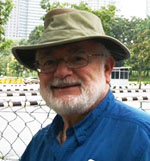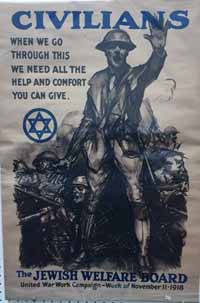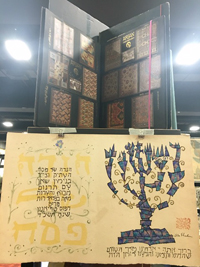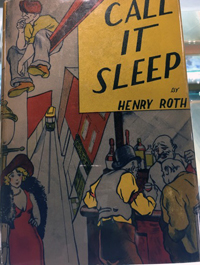By Oliver B. Pollak

OAKLAND, California – The 52nd California International Antiquarian Book Fair met at the Marriott City Center in Oakland. About 160 booksellers from around the world had brought their high priced prizes; a 1632 Shakespeare volume for $450,000, a Gutenberg Bible leaf (ca 1455), $98,000, Sir Isaac Newton’s 1704 Opticks $120,000, and Adam Smith’s 1776 Wealth of Nations, $125,000. Were they overpriced? not if you were a moneyed collector of quality. There were about 160 exhibits. Twenty-four hailed from the Brexit embroiled United Kingdom, and 19 from 11 other countries.
I was here for Judaica and cookbooks. There were four Hebraica & Judaica exhibitors, Davar Antiquarian Books and Eric Chaim Kline of California, Földári Books (Budapest), and Shapero Rare Books Ltd (London), not to be confused with Shapiro and Valentine, an earlier London Judaica bookstore.
But you don’t have to be Jewish to carry Jewish related wares. World War I, the War to Make the World Safe for Democracy, the Great War (before it was demoted to First by the Nazis), or to paraphrase Doris Lessing, I’m still not over WWI. Perhaps it’s because my father was in Vienna at the time, and my Grandfather healed for the Kaiser. As a front line surgeon, shrapnel in the arm terminated those skills.
 The Jewish Welfare Board poster reverberated. Where do troops chill, kick back, have some beer? Protestants formed the YMCA in the 1840s, Catholics established the Knights of Columbus in 1882, and Jews formed the JWB on April 9, 1917. America had entered the war on April 2. You can have this big piece of WWI memorabilia for $300.
The Jewish Welfare Board poster reverberated. Where do troops chill, kick back, have some beer? Protestants formed the YMCA in the 1840s, Catholics established the Knights of Columbus in 1882, and Jews formed the JWB on April 9, 1917. America had entered the war on April 2. You can have this big piece of WWI memorabilia for $300.

Haggadahs, the works of Ben Shahn and Arthur Syzk, transcendent Jewish icons of print, were scattered around the hall. One Shahn was by chance juxtaposed under a book on Afghan rugs. Nazi propaganda, World War II and concentration camp literature on Auschwitz and Adolph Eichmann were omnipresent including from Tblisi, the capital of Georgia.
Eric Chaim Kline of Santa Monica displayed the Ten Plagues in 10 hand-colored copperplates by Balthasar Friedrich Leizelt published in Augsburg ca 1760.
The first plague, turning water to blood, shows the Nile colored red. The buildings alongside the river look very Florentine or Venetian ($12,500). The captions were in German and French.

Davar [the word in Hebrew] Antiquarian Books in Downey, California owned by Robert Ari Grossman had a 1790 pamphlet, Naamen en Woonplaatßen, (names and addresses) and years of graduation of 115 medical doctors who lived in Amsterdam with the last page listing 15 Jewish doctors ($700).
Davar also had a 1784 dissertation from the University of Leipzig by the first Jewish student to attend that school ($1,000). My maternal grandfather, Felix Bachmann graduated from Christian Albrechts Kiel University medical school. Pictured here are his 1907 inaugural dissertation on Postoperative Parotitis as well as the receipts for printing and binding (priceless).

A local online out of the house bookseller with a 150,000 volume stock in three storage facilities had a beautiful copy of Call It Sleep published by Henry Roth in 1934, with a stunning dust jacket ($5,000). Roth did not publish on the same scale until 1994. He was born in a part of Austro-Hungary, now Ukraine in 1906. He died in 1995 at the age of 89.
The light touch theme of the book fair was a congregation of Wizard of Oz aficionados who displayed their NFS (Not for sale) notions. Anything Jewish in that? According to Robert A. Cohen and Heeb, in print from 2002 to 2010, and now on line, the Cowardly Lion, played by Bert Lahr (born Irving Lahrheim) “betrays his Jewish roots when he laments, ‘If I only had the noive.”
I will continue to love books out of my economic reach. Our adventure closed with gustatory abandonment of portion control at Oakland’s highly regarded Chinese restaurant Shan Dong, leaving me to think about the four gastronomic exhibits.
Getting to the convention Center was an adventure. We have been in the Bay Area for a little over two years but have been chary of public transport. We have only taken BART (Bay Area Rapid Transit) when we were chaperoned by the Women’s March or as grandparents accompanying a 3rd grade class guided by school teachers.
My wife got Clipper Cards for seniors to take the new ferry from Richmond to the Embarcadero Ferry building in San Francisco. It is also applicable to BART and buses. Normally Karen drives or if we both want to imbibe and not search for parking and reduced anxiety, we take Uber. So we drove to BART El Cerrito del Norte, free parking after 3 pm, and got on BART. Twenty minutes and a 382-foot walk later we were at the Convention Center.
*
Pollak, a professor emeritus of history at the University of Nebraska Omaha, and a lawyer, is a correspondent now based in Richmond, California. He may be contacted via oliver.pollak@sdjewishworld.com